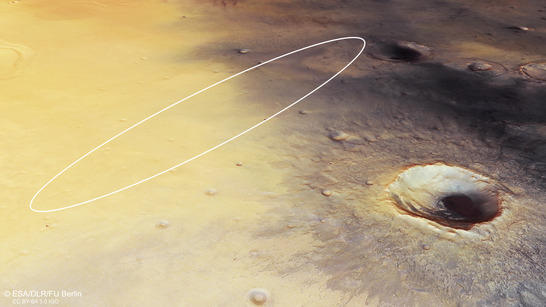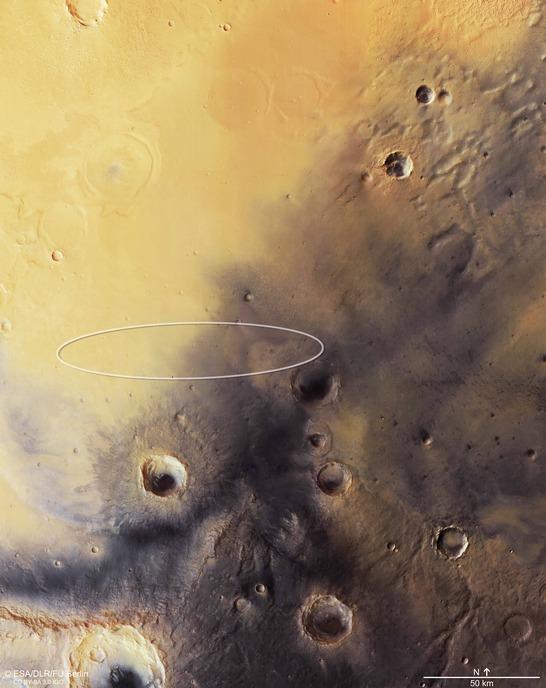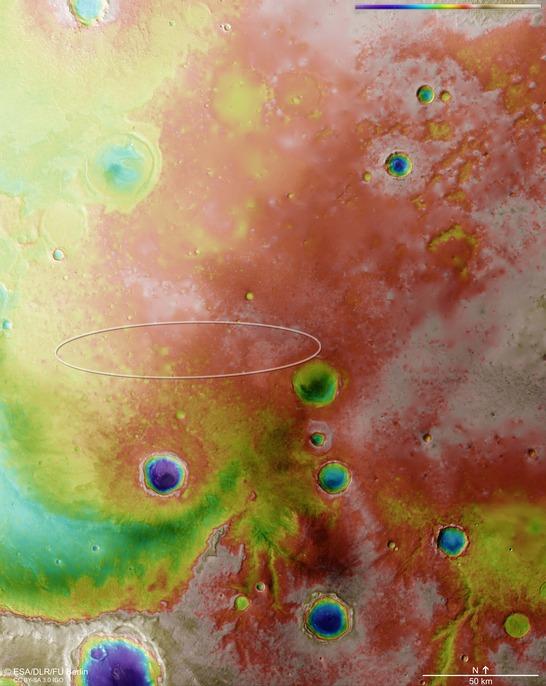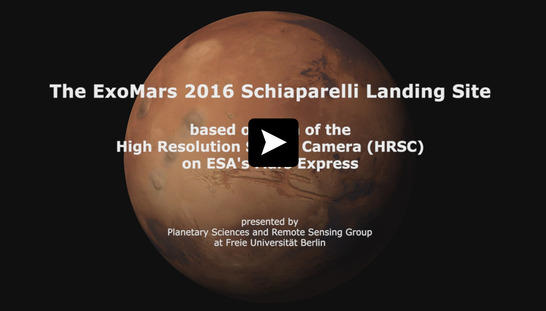Spotlight on the Schiaparelli landing site
On 14 March 2016 the European Mars mission ExoMars 2016 was launched. The landing module Schiaparelli and the Trace Gas Orbiter (TGO) are scheduled to arrive at Mars in October 2016. Here we show a mosaic of Schiaparelli’s landing site prepared from image data of the High Resolution Stereo Camera (HRSC) on board Mars Express by the Planetary Sciences and Remote Sensing group at Freie Universität Berlin. The systematic processing of the HRSC image data was carried out at the DLR Institute of Planetary Research in Berlin-Adlershof.
Schiaparelli is the Entry, Descent and Landing Demonstrator Module (EDM) of ESA’s ExoMars 2016 mission, which will land on Mars on 19 October 2016. Three days before reaching Mars, EDM will be separated from the orbiter. Soft landing will be enabled by aerobraking, parachutes, and a thruster system. At the Martian surface, different sensors on board will record the wind speed, humidity, pressure and temperature, as well as electric fields. With these measurements scientists hope to better understand the origin of dust storms on Mars.

Schiaparelli landing side perspective
The landing site of Schiaparelli is shown in this HRSC-mosaic of the Meridiani Planum region in the Southern Highlands of Mars, delineated by an ellipse that measures 100 km East-West and 15 km North-South. This area is relatively flat and smooth and has been selected due to safety reasons.

Schiaparelli landing side color image
South-East of the landing ellipse the impact crater Endeavour is located, which has been studied by the Opportunity rover since 2011. NASA sent Opportunity and its twin rover Spirit to Mars in 2003. Spirit has been operating at Gusev crater until 2010, whereas Opportunity is still active, investigating clay sediments at the western rim of Endeavour crater at the moment. The rover also discovered dune fields in Endeavour that move by wind and dust storms. Sulfates and clays detected in-situ and from orbit are probably associated with a combination of groundwater and surface water. In addition, fine-grained rocks in Meridiani Planum hint to a shallow marine setting in the Martian past.

Schiaparelli landing side color coded digital terrain model
Image processing and the HRSC experiment on Mars Express
The mosaic consists of four orbit strips (2064, 2075, 2086, 8423) and covers a region 352.5°-356.5° East and 4.5° South to 0.5° North. The color mosaic was created using data from the nadir channel, the field of view of which is aligned perpendicular to the surface of Mars, and the color channels of the HRSC. The oblique perspective view was generated using data from the HRSC stereo channels. The color-coded topographic view is based on a digital terrain model (DTM) of the region, from which the topography of the landscape can be derived. The reference body for the HRSC-DTM is a Mars sphere.
Mapserver
To download released raw images and DTMs of the region in GIS-ready formats, follow this link to the mapserver
Copyrights
Images: ESA/DLR/FU Berlin, CC BY-SA 3.0 IGO
Animation: ESA/DLR/FU Berlin, CC BY-SA 3.0 IGO
Music: RudySeb, CC BY-SA 2.0, and Adrian Neesemann
Copyright Notice:
Where expressly stated, images are licenced under the Creative Commons Attribution-ShareAlike 3.0 IGO (CC BY-SA 3.0 IGO) licence. The movie (without music) is licenced under the Creative Commons Attribution-ShareAlike 3.0 IGO (CC BY-SA 3.0 IGO) licence. The user is allowed to reproduce, distribute, adapt, translate and publicly perform it, without explicit permission, provided that the content is accompanied by an acknowledgement that the source is credited as 'ESA/DLR/FU Berlin', a direct link to the licence text is provided and that it is clearly indicated if changes were made to the original content. Adaptation / translation / derivatives must be distributed under the same licence terms as this publication.
The High Resolution Stereo Camera was developed at the German Aerospace Center (DLR) and built in collaboration with partners in industry (EADS Astrium, Lewicki Microelectronic GmbH and Jena-Optronik GmbH). The science team, which is headed by Principal Investigator (PI) Ralf Jaumann, consists of 52 co-investigators from 34 institutions and 11 countries. The camera is operated by the DLR Institute of Planetary Research in Berlin-Adlershof.
